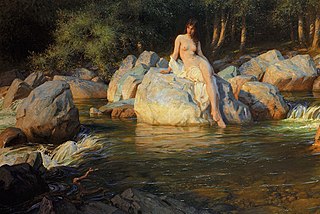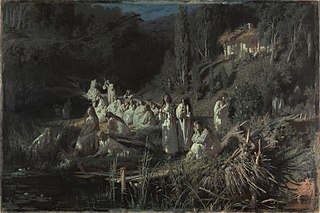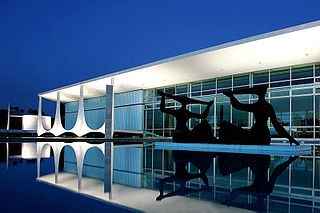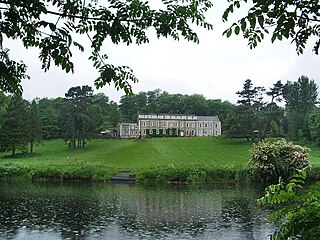Related Research Articles

The River Tees, in England, rises on the eastern slope of Cross Fell in the North Pennines and flows eastwards for 85 miles (137 km) to reach the North Sea in the North East of England. The modern day history of the river has been tied with the industries on Teesside in its lower reaches, where it has provided the means of import and export of goods to and from the North East England. The need for water further downstream also meant that reservoirs were built in the extreme upper reaches, such as Cow Green.

A kelpie, or water kelpie, is a shape-shifting spirit inhabiting lochs in Irish and Scottish folklore. It is usually described as a grey or white horse-like creature, able to adopt human form. Some accounts state that the kelpie retains its hooves when appearing as a human, leading to its association with the Christian idea of Satan as alluded to by Robert Burns in his 1786 poem "Address to the Devil".

The Nixie, Nixy, Nix, Näcken, Nicor, Nøkk, or Nøkken are humanoid, and often shapeshifting water spirits in Germanic mythology and folklore.
Enchantress most commonly refers to:
The Denham Tracts constitute a publication of a series of pamphlets and jottings on folklore, fifty-four in all, collected between 1846 and 1859 by Michael Aislabie Denham, a Yorkshire tradesman. Most of the original tracts were published with fifty copies. The tracts were later re-edited by James Hardy for the Folklore Society and imprinted in two volumes in 1892 and 1895. It is possible that J.R.R. Tolkien took the word hobbit from the list of fairies in the Denham Tracts.
Jenny Greenteeth a.k.a. Wicked Jenny, Ginny Greenteeth and Grinteeth is a figure in English folklore. A river-hag, similar to Peg Powler and derived from the grindylow, she would pull children or the elderly into the water and drown them. The name is also used to describe pondweed or duckweed, which can form a continuous mat over the surface of a small body of water, making it misleading and potentially treacherous, especially to unwary children. With this meaning the name is common around Liverpool and southwest Lancashire.

In Slavic folklore, the rusalka is a typically feminine entity, often malicious toward mankind and frequently associated with water, with counterparts in other parts of Europe, such as the French Melusine and the Germanic Nixie. Folklorists have proposed a variety of origins for the entity, including that they may originally stem from Slavic paganism, where they may have been seen as benevolent spirits. Rusalki appear in a variety of media in modern popular culture, particularly in Slavic language-speaking countries, where they frequently resemble the concept of the mermaid.

Glashtyn is a legendary creature from Manx folklore.

Iara, also spelled Uiara, Yara or Hiara or Mãe das Águas, is a figure from Brazilian mythology based on the ancient Tupi and Guaraní mythology. The word derives from Old Tupi yîara = y ("water") + îara = "lady of the lake". Depending on the oral tradition and the context of the story, she can be seen either as a water nymph, a siren, or a beautiful mermaid that lives in the Amazon River.

A hag is a wizened old woman, or a kind of fairy or goddess having the appearance of such a woman, often found in folklore and children's tales such as "Hansel and Gretel". Hags are often seen as malevolent, but may also be one of the chosen forms of shapeshifting deities, such as The Morrígan or Badb, who are seen as neither wholly benevolent nor malevolent.
A water spirit is a kind of supernatural being found in the folklore of many cultures:
A Thrummy-cap is a character in Scottish folklore, that appears in many tales. It may have been invented by John Burness in his 1796 Thrummy Cap, A Legend of the Castle of Fiddes.

Waddow Hall is a 17th-century Grade II listed building within a 178-acre (72 ha) estate that serves as a conference and activity centre for Girlguiding UK near Clitheroe, Lancashire. Waddow Hall has been managed by Girlguiding since 1927.

In mythology and folklore, a vengeful ghost or vengeful spirit is said to be the spirit of a dead person who returns from the afterlife to seek revenge for a cruel, unnatural or unjust death. In certain cultures where funeral and burial or cremation ceremonies are important, such vengeful spirits may also be considered as unhappy ghosts of individuals who have not been given a proper funeral.

The sjörå(in Swedish), or the Sjöfru was a mythical creature of the lake, or Rå, in Swedish folklore. She is a female, humanoid water spirit. She is a seductive creature, often featured sitting and combing her long, sweeping hair with delight, and often lures and drowns men who are unkind, unfaithful or otherwise disrespectful to her or the lake. Like all other rå (keepers) she protects her domain and awards those kind to her with good fishing luck and saves them from drowning. In wintertime she would sometimes stick her hand up from the waters. If the visitor then gave her a mitten she would thank him for his kindness with gifts or protect him in his time of need.
Nelly Longarms is a hag and water spirit in English folklore who dwells at the bottom of deep ponds, rivers and wells. Like the Grindylow, Peg Powler and Jenny Greenteeth she will reach out with her long sinewy arms and drag children beneath the water if they get too close. She is regarded as a bogeyman figure who is invoked by parents to frighten children into appropriate deportment.
In Slavic mythology, bolotnik, balotnik, bolotyanik or błotnik is a male swamp spirit. There are many descriptions of bolotnik. Usually he was portrayed as a man or an old man who has big, frog-like eyes, a green beard and long hair. His body is covered with dirt, algae and fish scales. The legends from the Vitebsk Governorate of Russia said that bolotnik is a dirty, fat, eyeless creature that motionlessly sits at the bottom of the swamp. In some accounts bolotnik is also said to have long arms and a tail. Just like the majority of Slavic water spirits, he would lure and drag people into the water if they get close to the edge. It is believed that bolotnik has neither wife nor children; in the other legends he is married to bolotnitsa, a female swamp spirit.

In Slavic paganism there are a variety of female tutelary spirits associated with water. They have been compared to the Greek Nymphs, and they may be either white (beneficent) or black (maleficent). They may be called Boginki, Navki, Rusalki, and Vily.
La Tulevieja, is a legendary figure from Costa Rican and Panamanian folklore. She is a ghost who wears a distinctive hat called a tule.
References
- 1 2 Briggs, Katharine (1976). An Encyclopedia of Fairies. Pantheon Books. pp. 323–324. ISBN 0394409183.
- ↑ Denham, Michael and Hardy, James (1895). Denham Tracts (Vol. 2). David Nutt for The Folklore Society. p. 42.
- ↑ Henderson, William (1879). Folklore of the Northern Counties of England and the Borders (2nd ed.) W. Satchell, Peyton & Co. p. 265.
- ↑ Denham and Hardy (1895). p. 78.
- ↑ O'Donnell, Elliott (1924). Ghosts, Helpful and Harmful. Richard Clay & Sons. pp. 199–202.
- ↑ Brown, Glen James, 1982- (2018). Ironopolis. Cardigan. ISBN 978-1-912109-14-2. OCLC 1015813513.
{{cite book}}: CS1 maint: location missing publisher (link) CS1 maint: multiple names: authors list (link) CS1 maint: numeric names: authors list (link)